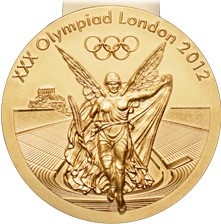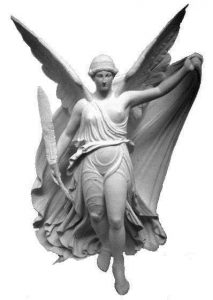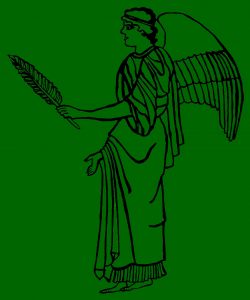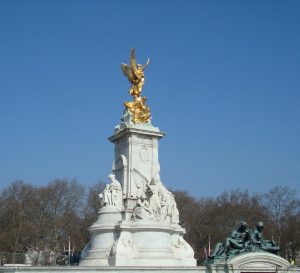
Recently Nike, the Greek goddess of Victory, landed in London on magnificent uplifted wings. There were frequent sightings of her in newspapers and on television, being fondled, flourished and quite often bitten by winning athletes. As the goddess who brings success in competitive activities, Nike had pride of place on the medals awarded for Olympic events.
In the lull between the main games and the Paralympics all kinds of questions were raised about the role of sport in UK schools. Should the two hours a week target introduced by Labour be reinstated? Does sport need to be competitive, or are energetic pursuits like Indian dancing just as useful? The debate ranged beyond issues of physical training. When a storm blew up about GCSE grades being lowered, Baroness Perry, Tory spokesperson on education in the Lords, offered the following justification in an interview on the ‘Today’ programme. Educational attainment, she said, is like a race: “You do need to have your gold medallists and your silver medallists and your bronze medallists, and that was beginning to be badly eroded. Almost everybody got a prize.” In other words, it’s not enough for people to do well at school. What we really need is for a few people to do better than the others. Our society, apparently, needs failure as much as it needs success. Would the goddess Nike have approved?
The answer is almost certainly, ‘Yes’. In ancient Greece, Nike presided over the Olympic Games in the form of a stunning 3-metre-high statue which overlooked the sports stadium in the sanctuary of Zeus at Olympia. For the Greeks an athletics festival was a way of worshipping the gods through physical excellence; and Zeus, as the ruler of Greece’s many deities, was honoured with the biggest and best of the Games. Nike was there to pay tribute to the victors. The statue’s sculptor Paionios carved her from a single block of marble, and placed her on top of a 6-metre-high column, looking for all the world as though she’d just alighted there amid a great flapping of her wings. A rushing wind has pressed her tunic against her body, and she raises one arm in the air, while in the other she carries a palm frond. Just imagine how the winning athlete would have felt, being greeted by such a figure

An inscription which was once on the base of the statue tells us that this particular Nike had been dedicated to Zeus by the Messenians, the people in whose territory Olympia lay, to commemorate a famous military victory. It goes on to say that the statue ‘was made by Paionios of Mende, who also won the competition to create the ornaments for the roof of the temple’. That Nike might see it as her duty to honour victories on the battlefield as well as in the sports stadium is an idea we can readily appreciate. But what about the sculpting competition – did that kind of contest come within the goddess’s remit as well?
Definitely. The contest, or ‘agon’, has been identified as one of the most significant driving forces in ancient Greek civilisation. The list of endeavours for which Nike awarded prizes includes drama, pottery making, the carving of statues, poetry, lyre playing, male and female physical beauty, choral singing, and even wool working. In all these areas the quest for excellence often took place in a competitive context, and was supervised by the great winged goddess herself. Even the cherished political freedoms of the Greeks were to some extent inspired by the notion of Nike. In the democratic states at least – with Athens at their head – decisions were made on the basis of public debate, or a contest of words. Philosophical concepts too were formulated in a spirit of competition: Socrates for one believed that the truth could only be reached via a personal dialogue, or dialectic, between two or more participants with opposing views.
The Greek poet Hesiod expressed it in this way:
“There is more than one form of Strife. In fact, there are two. One is praised by everyone who has made her acquaintance, the other is hated. They are quite different in character. Cruel Strife fosters battles and wicked warfare; the other – elder daughter of darkest Night – is much more positive. She prods even the lazy man into working when he sees his neighbour grow rich from ploughing and planting and tending his household. So neighbour competes with neighbour in the race to gain wealth. This kind of Strife is good for us. Potter competes with potter, builder with builder, and beggar with beggar; and the poet too strives to outshine his fellow poet.”
(Hesiod, Works and Days 11-26)
Most of the activities in which Nike involved herself were ones which in ancient Greece were pretty well dominated by men. But there was one area of life where Nike regularly appeared to offer her congratulations to women. On vases created to celebrate marriages, Nike can often be seen hovering over the bride’s head, holding out a festive wreathe. Nowadays we may be tempted to say that the goddess has turned up at the wedding to give the young woman a pat on the back for having ‘got her man’. But since most marriages in Greece were arranged between the groom and the bride’s father, this wasn’t really how it worked. It is probably more a case of the woman being applauded by Nike for having achieved her first important goal in life. Just as men were seen as fulfilling themselves in battle or sporting activities, in politics or in creative pursuits, so women were believed to find fulfilment in marriage and giving birth to children. For a woman, this was where her victory lay – according to Greek men, at any rate. The next time Nike will be seen winging her way into a young wife’s home is when she and her husband are celebrating the birth of a son. At that point the woman really will have crossed what most Greek males regarded as the finishing-line of her existence.

So as far as the Greeks were concerned, quality products and performances were achieved through competition. This meant that you had to embrace the notion of failure. In the recent Games it broke our hearts when people who had ‘only’ achieved silver shed tears and apologised for having let their countries down. Don’t worry about it, we wanted to say – you came second, didn’t you? But their response was certainly in the spirit of the original Olympians – if you didn’t come first, you’d lost. There were no prizes at all for coming second or third.
The British Museum is home to a whole host of Nikes. She can be seen there in statues and vase-paintings, on seal-stones and silver coins, and even in the form of a pair of exquisite ear-rings – items of gold Nike jewellery could add the finishing touches to a beauty which would one day lead to a woman’s triumph in marriage. Recently she also featured in a display devoted to the medals awarded at the London Games. David Watkins’ design for the gold, silver and bronze medals presented at the main games features the now familiar image of the goddess, closely based on the statue at Olympia. The Paralympic medals created by Ling Cheung evoke the spirit of Nike in a more abstract fashion, with a small detail of her swirling drapery (taken from a cast of the Nike statue at Olympia) on one side, and a close-up of the feathers from one of her wings on the other. Medals like these were introduced in 1896 at the first Modern Olympics, and Nike has been the main focus of their design since 1928. But medals themselves are an innovation – at the ancient Games the winners were presented with wreathes of intertwined olive stems from a tree in the sanctuary which was sacred to Zeus.
Another good place to see Nike in London is in front of Buckingham Palace. She appears there on the pinnacle of an elaborate memorial dedicated to the Queen who conveniently bore the same name as Nike’s Roman counterpart, Victoria. Designed by Sir Aston Webb, the monument was unveiled in 1911, ten years after Victoria’s death. The ceremony was performed by two of the Queen’s most prominent grandsons, King George V and the German Emperor Wilhelm II. The crowning figure, made from gilded bronze, is loosely based on Olympia’s Nike. Here the goddess is being employed in a celebration of militarism and Empire which undeniably corresponds with one of her ancient functions. But it strikes a bitter note when we bear in mind that three years after its dedication the two royal protagonists and their subjects were being propelled into the horrendous conflict of the First World War.

So why does the goddess Nike have wings? Winged deities were fairly unusual in ancient Greece, with Eros the god of Love and Sex providing the other commonly encountered example. The image of flight which Nike embodies certainly involves on one level the notion of Victory’s transience. One famous representation, the headless Nike of Samothrace in the Louvre in Paris, wonderfully evokes the tremendous force and vigour of the goddess’s arrival among us. Much less poised than in the earlier version at Olympia, Nike is seen here as a goddess who swoops and whirls and restlessly beats her wings. Any deity who comes to visit us in this dramatic fashion is almost certain to take off again with equal speed and determination. There’s nothing that humans can possibly do to detain her. Towards the end of the fifth century BCE the Athenians had attempted to pin Nike down by giving her a temple on the Acopolis where she was depicted without wings, and in the act of taking off her sandals – they were determined that this time the goddess was here to stay. But in the end this was an illusion. Twenty years later the rich and powerful Athenians were comprehensively defeated by the Spartans in the Peloponnesian War, and a golden age in Athens’ history came to an end.
So Victory (like Eros?) can never last – a message reinforced by the wreathes presented to victors at the Games, which unlike our medals were bound to wither and die. But Nike’s wings have other more uplifting meanings. She may not stay for long, but while she is here Nike is able to carry us upwards into the heavens. Whether it’s in a race, a sculpture, a poem or a wedding, the spirit of Nike raises us aloft, beyond the level of the ordinary, if only for a moment.
And why, finally, is Nike a female, when so many of the activities which she helped to celebrate were exclusively male? One overall explanation may be that the Greeks commonly employed female figures – such as Peace (Eirene), Justice (Dike) or Good Order (Eunomia) – to denote abstract concepts with political or social significance in the masculine sphere. Like the figures of Liberty and Justice which still adorn our civic spaces, these females could be used to represent important public values because women were seen as existing beyond the realm of the normal. They might be positioned above or below men, but they were never on the same level.
Perhaps, more specifically, Nike was viewed as female because she was linked to another important feminine personification – that of Metis. Metis was both a quality, and a minor goddess (one of the early wives of the god Zeus). Her name is often translated as ‘cunning intelligence’, but is perhaps better evoked by words such as ‘Flair’, ‘Ingenuity’, or even ‘Lateral Thinking’. Trickiness and unpredictability were seen by the Greeks as fundamentally feminine characteristics. Being physically weaker than men, women often had to resort to less-than-straightforward ways of achieving their objectives. But men sometimes had to employ the same tactics in order to surpass the limits of the ordinary, and succeed as athletes, fighters or artists. They needed Metis, in other words. Victory can only be won if we are alert to all the opportunities which complexity, uncertainty and chance can offer us. Sometimes at the Greek Games this meant actually cheating – there were plenty of examples of this at the ancient Olympics. But mostly it referred simply to seizing the moment – exploiting your strengths in the immediate situation in which you found yourself – and winning through to glory. Chance, and the ability to use it, are bound to play a part in all our endeavours. Sport would be no fun at all if the outcome could always be predicted.=
So welcome to London, Nike. It’s been lovely having you here in our city. But perhaps the time has come to bid you a fond farewell. The Games were magnificent, and I for one am really glad that they happened. But I’m not sure I want to live for ever in a country where only a few can be allowed to achieve excellence – where winning inevitably depends on the creation of losers. So have a good flight back to Greece, dear goddess. I think they may be missing you there at the moment.
October 2012

